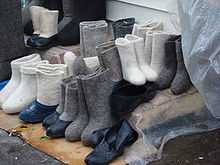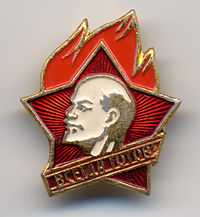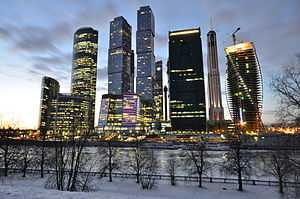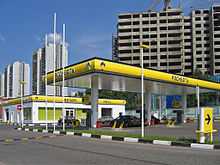Tourism in Russia
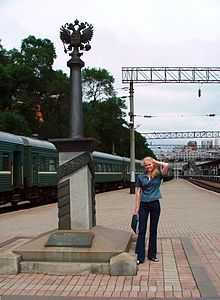
Tourism in Russia has seen rapid growth since the late Soviet times, first inner tourism and then international tourism as well. Rich cultural heritage and great natural variety place Russia among the most popular tourist destinations in the world. The country contains 23 UNESCO World Heritage Sites, while many more are on UNESCO's tentative lists.[1] Major tourist routes in Russia include a travel around the Golden Ring of ancient cities, cruises on the big rivers like Volga, and long journeys on the famous Trans-Siberian Railway. Diverse regions and ethnic cultures of Russia offer many different food and souvenirs, and show a great variety of traditions, like Russian banya, Tatar Sabantuy, or Siberian shamanist rituals.
Unless exempt, tourists to Russia are required to purchase a visa, in addition to having a valid passport. Visas cannot be purchased at the border, and once at the border must be presented with other relevant documents.
Statistics
In 2012, 25.7 million international tourists arrived in Russia and brought US$11.2 billion in international tourism receipts to the country.[2] Including domestic and international tourism, the industry directly contributed RUB860 billion to Russian GDP and supported 966,500 jobs in the country.[3]
Cultural tourism

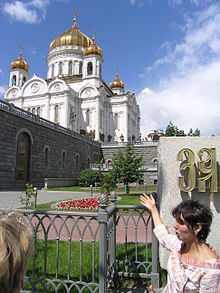
Most popular tourist destinations in Russia are Saint Petersburg (which appeared in the list of top visited cities of Europe in 2010) and Moscow, the current and the former capitals of the country and great cultural centers, recognized as World Cities. Moscow and Saint Petersburg feature such world-renown museums as Hermitage and Tretyakov Gallery, famous theaters like Bolshoi and Mariinsky, ornate churches like Saint Basil's Cathedral, Cathedral of Christ the Saviour, Saint Isaac's Cathedral and Church of the Savior on Blood, impressive fortifications like Moscow Kremlin and Peter and Paul Fortress, beautiful squares like Red Square and Palace Square, and streets like Tverskaya and Nevsky Prospect. Rich palaces and parks of extreme beauty are found in the former imperial residences in suburbs of Moscow (Kolomenskoye, Tsaritsyno) and Saint Petersburg (Peterhof, Strelna, Oranienbaum, Gatchina, Pavlovsk Palace, Tsarskoye Selo). Moscow contains a great variety of impressive Soviet era buildings along with modern scyscrapers, while Saint Petersburg, nicknamed Venice of the North, boasts of its classical architecture, many rivers, channels and bridges.
Kazan, the capital of Tatarstan, shows a unique mix of Christian Russian and Muslim Tatar cultures. The city has registered a brand The Third Capital of Russia, though a number of other major Russian cities compete for this status, like Samara, Novosibirsk, Yekaterinburg and Nizhny Novgorod, all being major cultural centers with rich history and prominent architecture. Veliky Novgorod, Pskov, Dmitrov and the cities of Golden Ring (Vladimir, Yaroslavl, Kostroma and others) have at best preserved the architecture and the spirit of ancient and medieval Rus', and also are among the main tourist destinations. Many old fortifications (typically Kremlins), monasteries and churches are scattered throughout Russia, forming its unique cultural landscape both in big cities and in remote areas.
Resorts and nature tourism


The warm subtropical Black Sea coast of Russia is the site for a number of popular sea resorts, like Sochi, known for its beaches and wonderful nature. At the same time Sochi can boast a number of major ski resorts, like Krasnaya Polyana; the city is the host of 2014 Winter Olympics. The mountains of the Northern Caucasus contain many other popular ski resorts, like Dombay in Karachay–Cherkessia.
The most famous natural tourist destination in Russia is Lake Baikal, named the Blue Eye of Siberia. This unique lake, oldest and deepest in the world, has crystal-clean waters and is surrounded by taiga-covered mountains.
Other popular natural destinations include Kamchatka with its volcanoes and geysers, Karelia with its many lakes and granite rocks, Altai with its snowy mountains and Tyva with its wild steppes.
| ||||||||||||||||||||||||||||||||
Souvenirs and food
Typical souvenirs include Matryoshka doll and other handicraft, samovars for water heating, ushanka and papaha warm hats, and fur clothes among other items. Russian vodka and caviar are among the food that attracts foreigners, along with honey, blini, pelmeni, borsch and other products and dishes of Russian cuisine.
-

Matryoshka
-

Garmoshka
-

Selyodka
-

Borsch
Foreign visitor arrivals in 2012
 Germany: 375,285
Germany: 375,285 China: 343,357
China: 343,357 United States: 179,763
United States: 179,763 United Kingdom: 135,949
United Kingdom: 135,949 Finland: 120,306
Finland: 120,306 Italy: 118,729
Italy: 118,729 Turkey: 100,918
Turkey: 100,918 France: 99,581
France: 99,581 Israel: 85,955
Israel: 85,955 Spain: 70,291
Spain: 70,291 South Korea: 48,425
South Korea: 48,425 Japan: 44,667
Japan: 44,667 Canada: 36,260
Canada: 36,260 Netherlands: 32,533
Netherlands: 32,533 Latvia: 32,125
Latvia: 32,125 Poland: 30,088
Poland: 30,088 Switzerland: 28,845
Switzerland: 28,845 Austria: 28,076
Austria: 28,076 Estonia: 27,436
Estonia: 27,436 India: 26,600
India: 26,600 Sweden: 23,862
Sweden: 23,862 Lithuania: 21,060
Lithuania: 21,060 Norway: 20,617
Norway: 20,617.svg.png) Belgium: 18,600
Belgium: 18,600 Denmark: 16,700
Denmark: 16,700 Greece: 14,500
Greece: 14,500 Mexico: 13,200
Mexico: 13,200
See also
References
- ↑ Tentative Lists
- ↑ "Tourism Highlights 2013 edition". UNWTO. Retrieved 2013-11-27.
- ↑ "2013 Travel & Tourism Economic Impact Report Russian Federation". WTTC. Retrieved 2013-11-27.
External links
| Wikivoyage has a travel guide for Russia. |
- Russia travel and tourism on the Open Directory Project
- Fully Personalized Itineraries for independent travel in Russia
- Representing in North America: Russian National Tourist Office
- (English) (Russian) Federal Agency for Tourism
| ||||||||||||||||||||||||||||||||||||||
| |||||||||||||||||||||||||||||||||||||||
| |||||||||||
| |||||||||||
| ||||||||||||||||||||||||










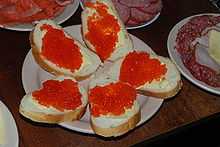
.jpg)


